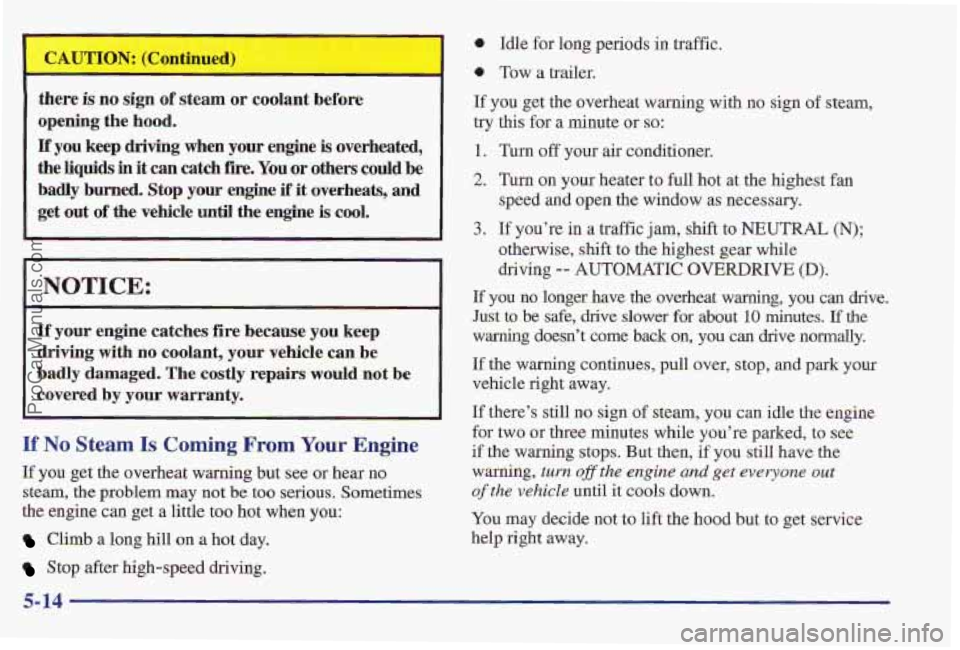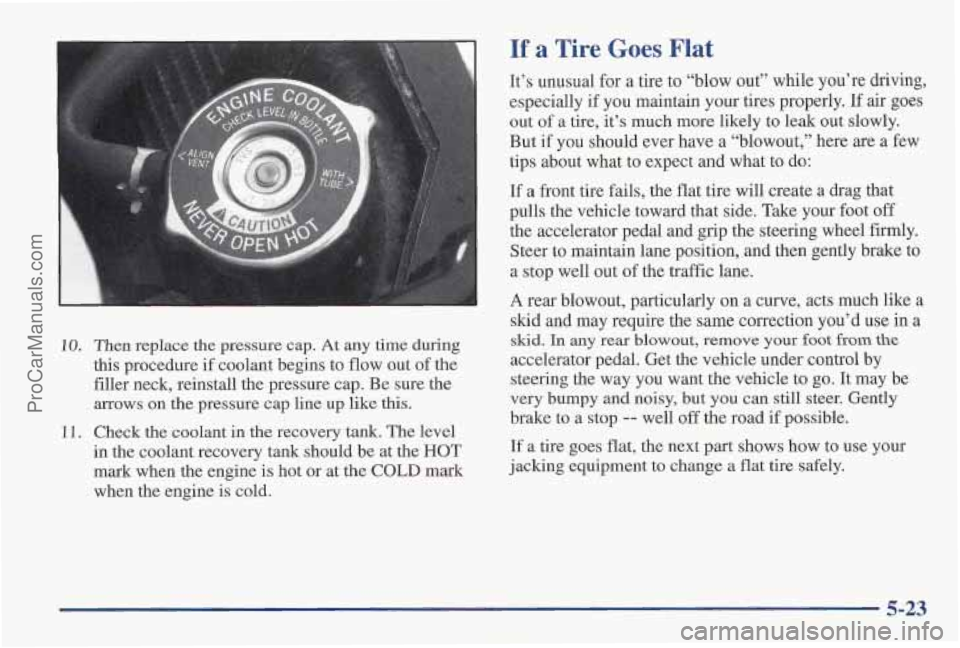Page 245 of 419
Attach a separate safety chain around the outboard end
of each lower control arm.
Rear Towing
A towing dolly must be used under the drive wheels when
towing from the real:
Note: Take care not to damage speed sensor wires when
attaching chains.
Use wheel lift or car carrier equipment. Additional
ramping may
be required for car carrier equipment. Use
safety chains and wheel straps.
5-11
ProCarManuals.com
Page 246 of 419
NOTICE:
Do not tow with sling-type equipment or the rear
bumper fascia will be damaged.
Towing a vehicle over rough surfaces could
damage
a vehicle. Damage can occur from
vehicle to ground or vehicle to wheel-lift
equipment,
To help avoid damage, install a
towing dolly and raise the vehicle until adequate
clearance
is obtained between the ground and/or
wheel-lift equipment.
Do not attach winch cables or J-hooks to
suspension components when using car carrier
equipment. Always
use '6-books inserted in the
T-hook slots.
Attach T-hook chains to the T-hook slots in the
floor pan support rails, just ahead of the rear wheels,
on both sides.
These slots are to be used when loading and securing to
car carrier equipment.
5-12
ProCarManuals.com
Page 248 of 419

tnere is no sign of steam or coolant before
opening the hood.
If you keep driving when your engine is overheated,
the
liquids in it can catch fire. You or others could be
badly burned. Stop your engine if it overheats, and
get out
of the vehicle until the engine is cool.
I NOTICE:
If your engine catches fire because you keep
driving
with no coolant, your vehicle can be
badly damaged. The costly repairs would not
be
covered by your warranty.
If No Steam Is Coming From Your Engine
If you get the overheat warning but see or hear no
steam, the problem may not be too serious. Sometimes
the engine can get a little
too hot when you:
Climb a long hill on a hot day.
Stop after high-speed driving. Idle for long
periods in traffic.
* Tow a trailer.
If you get the overheat warning with no sign of steam,
try this for a minute or so:
1. Turn off your air conditioner.
2. Turn on your heater to full hot at the highest fan
speed and open the window as necessary.
3. If you’re in a traffic jam, shift to NEUTRAL (N);
otherwise, shift to the highest gear while
driving
e- AUTOMATIC OVERDRIVE (D).
If you no longer have the overheat warning, you can dnve.
Just to be safe, drive slower for about 10 minutes. If the
warning doesn’t come back on, you can drive normally.
If the warning continues, pull over, stop, and park your
vehicle right away.
If there’s still no sign of steam, you can idle the engine
for two or three minutes while you’re parked, to see
if the warning stops. But then, if you still have the
warning, turn off the engine and get everyone out
of the vehicle until it cools down.
You may decide not to lift the hood but to get service
help right away.
5-14
ProCarManuals.com
Page 257 of 419

If a Tire Goes Flat
10. Then replace the pressure cap. At any time during
this procedure if coolant begins to flow out
of the
filler neck, reinstall the pressure cap. Be sure the
mows
on the pressure cap line up like this.
11. Check the coolant in the recovery tank. The level
in the coolant recovery tank should be at the HOT
mark when the engine is
hot or at the COLD mark
when the engine is cold. It’s unusual for
a tire to “blow out”
while you’re driving,
especially
if you maintain your tires properly. If air goes
out of a tire, it’s much more likely to leak out slowly.
But if you should ever have a “blowout,” here are a few
tips about what to expect and what to do:
If
a front tire fails, the flat tire will create a drag that
pulls the vehicle toward that side. Take your foot
off
the accelerator pedal and grip the steering wheel firmly.
Steer to maintain lane position, and then gently brake to
a stop well out
of the traffic lane.
A rear blowout, particularly on a curve, acts much like a
slud and may require the same correction you’d use in a
skid. In any rear blowout, remove your foot from the
accelerator pedal. Get the vehicle under control by
steering the way you want the vehicle to go. It may be
very bumpy and
noisy, but you can still steer. Gently
brake to a stop
-- well off the road if possible.
If a tire goes flat, the next part shows how to use your
jacking equipment to change a
flat tire safely.
ProCarManuals.com
Page 264 of 419
CAUTION: (Continued)
emergency, you can use a cloth
or a paper towel
to
do this; but be sure to use a scraper or wire
brush later, if you need to, to get all the rust or
dirt off.
I
Never use oil or grease on studs or nuts. If you
do, the nuts might come loose. Your wheel could
fall
off, causing a serious accident.
5. Replace the wheel nuts
with the rounded end
of the nuts toward the
wheel. Tighten each nut
by hand until the wheel
is held against the hub.
6. Lower the vehicle by turning the jack handle
counterclockwise. Lower the jack completely.
ProCarManuals.com
Page 269 of 419

If You’re Stuck: In Sand, Mud,
Ice or
Snow
What you don’t want to do when your vehicle is stuck is
to spin your wheels too fast. The method known as
“rocking” can help you get out when you’re stuck, but
you must use caution.
L
If you let your tires spin at high speed, they can
explode, and you or others could be injured.
And, the transaxle or other parts
of the vehicle
can overheat. That could cause an engine
compartment fire or other damage. When you’re
stuck, spin the wheels
as little as possible. Don’t
spin the wheels above
35 mph (55 km/h) as shown
on the speedometer.
NOTICE:
Spinning your wheels can destroy parts of your
vehicle as well as the tires.
If you spin the wheels
too fast while shifting your transaxle back and
forth, you can destroy your transaxle.
For information about using tire chains on your vehicle,
see “Tire Chains” in the Index.
Rocking Your Vehicle To Get It Out
First, turn your steering wheel left and right. That
will clear the area around your front wheels. If your
vehicle has the Trac System, you should turn the system
off. (See “Trac System” in the Index.) Then shift back
and forth between REVERSE (R) and
a forward gear,
spinning the wheels as little as possible. Release the
accelerator pedal while you shift, and press lightly on
the accelerator pedal when the transaxle
is in gear. If
that doesn’t get you out after a few tries, you may need
to be towed
out. If you do need to be towed out, see
“Towing Your Vehicle” in the Index.
ProCarManuals.com
Page 284 of 419
Checking Engine Oil
Pull out the dipstick and
clean it with
a paper towel
or cloth, then push
it back
in all
the way. Remove it
again, keeping the tip
down, and check
the level.
3100 Engine
When to Add Oil
If the oil is at or below the lower mark, then you’ll need
to add some oil. But you must use the right kind. This
part explains what kind of oil to use, For crankcase
capacity, see “Capacities and Specifications” in
the Index.
I NOTICE:
Don’t add too much oil. If your engine has so
much oil that the oil level gets above the
cross-hatched area that
shows the proper
operating
range, your engine could be damaged.
3100 Engine
ProCarManuals.com
Page 288 of 419

NOTICE:
Use only engine oil with the American Petroleum
Institute Certified For Gasoline Engines
“Starburst” symbol. Failure to use the
recommended oil can result in engine damage not
covered by
your warranty.
GM Goodwrench@ oil meets all the requirements for
your vehicle.
If you are in an area where the temperature falls below
-20°F (-29*C), consider using either an SAE 5W-30
synthetic oil or an SAE OW-30 oil. Both will provide
easier cold starting and better protection
for your engine
at extremely low temperatures.
Engine Oil Additives
Don’t add anything to your oil. Your Pontiac dealer is
ready
to advise if you think something should be added.
When to Change Engine Oil
If any one of these is true for you, use the short trip/city
maintenance schedule:
0 Most trips are less than 5 to 10 miles (8 to 16 km).
This
is particularly important when outside
temperatures are below freezing.
0 Most trips include extensive idling (such as frequent
driving in stop-md-go traffic).
0 Most trips are through dusty areas.
You frequently tow a trailer or use a carrier on top of
0 The vehicle is used for delivery s’ervice, police, taxi
Driving und’er these conditions causes engine oil to
break down sooner, If any one
of these is true €or your
vehicle, then you need to change your oil and filter
every
3,000 miles (5 000 km) or 3 months -- whichever
occurs first. (See “Change Oil Indicator” in the Index.)
If none of them is true, use the long triphighway
maintenance
schedule. Change th’e oil and filter every
7,500 miles (12 500 km) or 12 months -- whichever
occurs first, Driving
a vehicle with a fully warmed
engine under highway conditions causes engine oil
to
break down slower.
(See “Change Oil Indicator” in the Index.)
your vehicle.
or other commercial application,
6- 18
ProCarManuals.com